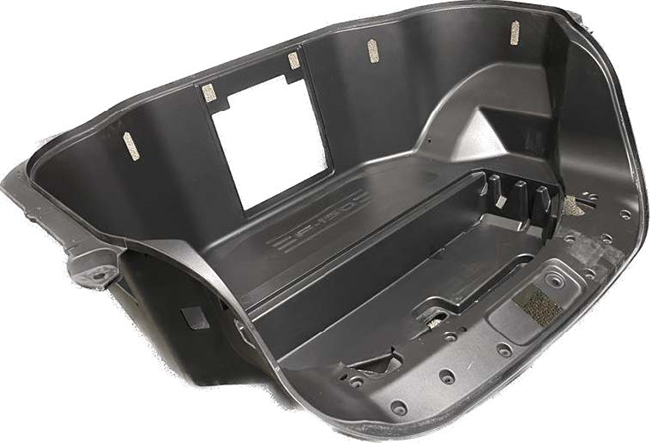Celanese Laser-focused on Sustainability
At NPE2024, the company discussed efforts to slash its carbon footprint not only in its engineering polymers but also in its manufacturing operations.
May 14, 2024

Celanese Corp., which is still digesting its 2022 acquisition of DuPont Co.’s Mobility & Materials unit, remains laser-focused on improving the sustainability not only of its wide range of engineering polymers but also on its manufacturing processes.
The $11 billion cash purchase of DuPont’s specialty plastics business has given the Dallas-based Celanese “the broadest portfolio of engineering thermoplastics in the industry right now,” said Tom Kelly, the firm’s senior vice president of engineered materials.
“We have over 20 different polymers that we can draw from to solve customer problems through formulation and compounding,” he said in a May 6 interview in the company’s suite at the NPE2024 trade show in Orlando, FL. “But for every one of those product lines, we either have options with recycled content, or we have alternatives that are produced with bio-sourced raw materials to provide a lower CO2 footprint versus conventional fossil-fuel feedstocks.”
Leveraging carbon capture.
Its efforts have not gone unnoticed. On May 9, the American Chemistry Council (ACC) presented Celanese with a 2024 Sustainability Leadership Award in the Circularity category. ACC recognized the company for the active carbon capture and utilization (CCU) project at its Clear Lake, TX, manufacturing site as part of its Fairway Methanol joint venture with Mitsui & Co. Ltd. The project is expected to capture 180,000 metric tons of CO2 industrial emissions and produce 130,000 metric tons of low-carbon methanol annually.
The CCU project takes CO2 industrial emissions that would otherwise be emitted into the atmosphere from both Celanese and third-party sources and applies reduced-carbon-intensity hydrogen to chemically convert the captured CO2 into a methanol building block used for downstream production. This low-carbon input is then used to reduce traditional fossil fuel–based raw materials to produce a range of products that can benefit most major industries.
Kelly noted that Celanese then is using this carbon-capture methanol to produce its polyoxymethylene (POM) — aka acetal — in its Bishop, TX, facility. The end result, he says, is a net-zero-carbon footprint for the POM ECO-C resin it is making there.
“This has customers really excited,” he said, “especially in the consumer space, in the electronics space, [which is] where you see most of the interest right now.”
Recent financial results.
On May 8, meanwhile, the global chemical and specialty materials company announced first-quarter financial results. It reported 2% higher net sales of $2.61 billion for the three months to the end of March 2024 and 33% higher net earnings of $124 million.
"Our first quarter results demonstrate our ability to execute in a commercial environment that has stabilized but still shows limited signs of meaningful recovery," said Lori Ryerkerk, chair and CEO. "We saw the realization of financial benefits from actions that were completed last year, particularly within the former M&M portfolio, and we continue to put in place further initiatives to enhance the earnings power of Celanese.”
Those actions included shutting down two former DuPont operations in Europe that Kelly said were at “the higher end of the cost curve.” The first was a nylon 6/6 polymerization unit in Uentrop in Germany last fall, and more recently a specialty compounding facility in Mechelen, Belgium.
Rolling out new grades.
Meantime, Celanese has introduced some new grades of former DuPont materials, including:
Vectra|Zenite LCP ECO-B, a liquid crystal polymer (LCP) made with up to 60% renewable content using a mass-balance approach.
Zytel High Performance Nylon (HPN) grades, which the company calls a transformative range of renewably sourced solutions designed for the consumer electronics sector. These grades offer ultra-low density combined with high modulus, enhancing the performance of devices such as smartphones, augmented reality and virtual reality gear, and other wearables.
Zenite LCP 16236(N), an ultra-high-flow, low-warpage LCP solution for miniaturization in connector applications. This material features excellent flow characteristics suitable for thin-wall applications, along with stable warpage control.
Bringing the frunk.
Late last year Celanese also earned a Grand Award in the Vehicle Interior category at the 52nd Annual SPE Automotive Innovation Awards for its role as a material supplier for the 2023 Ford F-150 Lightning Mega Power Frunk. The frunk— the front, trunk-like storage space that occupies the traditional engine compartment in an electric vehicle — used a 40% long-glass-fiber grade of the company’s injection-moldable Celstran polypropylene to replace sheet molding compound (SMC) for that part, which offers an industry-largest 400 liters of space.

Ford’s electric F-150 pickup, the Lightning, used Celanese’s LFRT Celstran PP to mold this award-winning, 21-pound “frunk.” Switching to injection molding from compression molding offered significant processing and cycle-time savings. Image courtesy of Celanese Corp.
“It's a pretty big piece of plastic,” Kelly said. “I think it's over 21 pounds. So, it was a real design challenge. We worked very closely with our supply chain partners to be able to make the mold and ultimately the part.”
Additionally, Celanese said, the cycle time reduction achieved by using injection molding instead of compression molding and eliminating the need to paint contributes to an annual savings of approximately $15 million. It also reduced the weight in each vehicle by 16 pounds.
This type of weight savings is especially vital in electric and hybrid vehicles, which need to maximize battery performance. That opens opportunities for replacing metal with polymers and polymer composites.
Kelly notes an automotive cross-beam application as a case in point. It uses Zytel PA 6/6 for the structural, under-car member, which, he said, is in “late-stage development” with an automaker.
Tuning EV motor mounts.
And Cadillac is using Celanese’s Zytel NVH, a structural material that can be tuned to reduce specific frequencies, for its Lyriq EV motor mounts. General Motors tried aluminum, but it created an undesirable sound in the passenger cabin. These plastic mounts produce a quieter interior experience by isolating and damping high-frequency motor noise, which becomes more prominent with quieter EVs. This innovation also won a nod from Automotive News’ PACE program with a nomination in 2022, and a Society of Automotive Analysts Innovations in Lightweighting award in 2023.

GM’s Cadillac Lyriq EV adopted Celanese’s Zytel NVH high-performance nylon for its motor mounts, reducing noise in the vehicle’s passenger cabin. Image courtesy of Celanese Corp.
Kelly noted another advantage that he says Celanese has. “We have a really strong position with the OEMs and [automotive tier suppliers] in China,” which is a leader in EV development.
“We tend to learn things in China about design principles and then we transfer those to the engineers in the US, and to Europe to make sure that we're ready. Because, ultimately, a lot of the same design challenges that the Chinese have already been facing will be coming up in the US and Europe, as well. So we’re more prepared for this.”
A major TPE portfolio.
Celanese also is active in other sectors. With two leading thermoplastic elastomer brands — Santoprene thermoplastic vulcanizates (TPVs) and Hytrel thermoplastic copolyesters (TPCs) — the company is getting more active in athletic footwear, for example.
The midsole on running shoes, he notes, traditionally has been made from ethyl vinyl acetate (EVA). Now, Kelly says, “customers started using our Hytrel to get more elasticity and bounce in in the running shoe. And we've been working with customers recently on foaming technology to not only give you even more elasticity, but lighter weight and still get those same bounce properties.”
The company is incorporating bio-based raw material options into these products, as well. At the same time, Santoprene TPV allows users to recycle any of the trimmed waste, unlike with thermoset EPDM rubber, which is not recyclable.
A more sustainable alternative to Spandex.
Additionally, as previously reported, Celanese has been working for years with Baltimore-based Under Armour Inc. (UA), the athletic apparel and footwear giant, to develop an alternative fiber for use in performance stretch fabrics. Its aim is to replace the long-established elastane (commonly known as Spandex). Kelly said elastane uses a lot of solvents in its manufacturing process that ultimately get released into the environment if not captured properly. Spandex also is not recyclable, he said.
So Celanese and UA recently introduced Neolast. This alternative “could unlock the potential for end users to recycle performance stretch fabrics,” claims Celanese, “a legacy aspect that has yet to be solved in the pursuit of circular manufacturing with respect to stretch fabrics.”
Neolast fibers are produced using a proprietary, solvent-free, melt-extrusion process, notes Kelly, adding that the fiber itself can be tailored to give very different properties.
Celanese says that in addition to exploring application opportunities with Under Armour, it intends to make the fiber available to the broader apparel industry, potentially reducing elastane dependence.
About the Author(s)
You May Also Like




